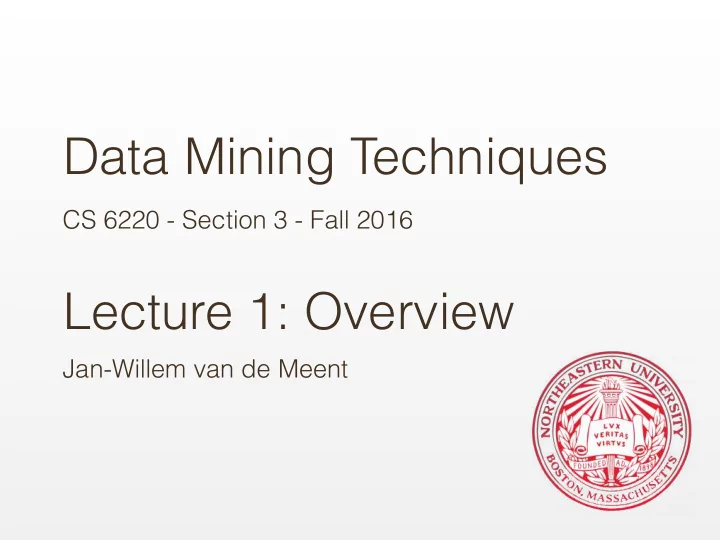

Data Mining Techniques CS 6220 - Section 3 - Fall 2016 Lecture 1: Overview Jan-Willem van de Meent
Who are we? Instructor Jan-Willem van de Meent Email : j.vandemeent@northeastern.edu Phone : +1 617 373-7696 Office Hours : 478 WVH, Wed 1.30pm - 2.30pm Teaching Assistants Yuan Zhong E-mail: yzhong@ccs.neu.edu Office Hours: WVH 462, Wed 3pm - 5pm Kamlendra Kumar E-mail: kumark@zimbra.ccs.neu.edu Office Hours: WVH 462, Fri 3pm - 5pm
Who are you?
Syllabus http://www.ccs.neu.edu/course/cs6220f16/sec3/
Course Objectives 1. Lectures: Understand data mining methods • Mathematical/algorithmic definitions • When should each method be used? • What are some limitations of each method? 2. Homework Problems: Use data mining methods • Implement methods • Use methods in existing libraries • Visualize results, evaluate effectiveness
Homework Problems • 4 or (more likely) 5 problem sets • 30% - 40% of grade (depends on type of project) • Can use any language (within reason) • Discussion is encouraged, but submissions must be completed individually (absolutely no sharing of code) • Submission via zip file by 11.59pm on day of deadline (no late submissions) • Please follow submission guidelines on website (TA’s have authority to deduct points)
Project Vote next week 1. Freeform : Develop your own project proposals • 30% of grade (homework 30%) • Present proposals after midterm • Peer-review reports 2. Predefined : Same project for whole class • 20% of grade (homework 40%) • More like a “super-homework” • Teaching assistants and instructors
Participation 1. Attend the Lectures 2. Ask questions! 3. Help Others
Self-evaluation For Homework Problems • Indicate time spent • What was easy / hard? • What did you learn? After Midterm and Final Exams • What was your favorite topic? • What parts were easier / more difficult to follow? • List 3 students that contributed to your understanding
Grading Freeform Project Predefined Project Homework: 30% Homework: 40% • • Midterm: 20% Midterm: 20% • • Final: 20% Final: 20% • • Project: 30% Project: 20% • • Participation (bonus): 10% Participation (bonus): 10% • •
What is Data Mining?
Intersection of Disciplines Database Statistics Technology Machine Data Mining Visualization Learning Information Other Science Disciplines
Knowledge Discovery in Databases (a.k.a. database system / data warehouse perspective) • • abase Pattern Evaluation • • in Data Mining Task-relevant Data evant Data Selection Selection Data Warehouse Data Cleaning Data Integration Databases
Data Mining ≃ Data Science (a.k.a. machine learning and statistics perspective) Data Post- Data Pre- Input Data Processing Processing Mining Pattern discovery Data integration Pattern evaluation Association & correlation Normalization Pattern selection Classification Feature selection Pattern interpretation Clustering Dimension reduction Pattern visualization Outlier analysis … … … … •
1. Types of Data
Matrix Data motor total ID age sex time Jitter(%) Shimmer NHR HNR RPDE DFA PPE UPDRS UPDRS 1 55 0 5.64 6.62E-03 0.02565 0.01 21.64 0.42 0.55 0.16 28.199 34.398 2 67 0 12.67 3.00E-03 0.02024 0.01 27.18 0.43 0.56 0.11 28.447 34.894 3 77 0 19.68 4.81E-03 0.01675 0.02 23.05 0.46 0.54 0.21 28.695 35.389 4 59 0 25.65 5.28E-03 0.02309 0.03 24.45 0.49 0.58 0.33 28.905 35.81 5 64 0 33.64 3.35E-03 0.01703 0.01 26.13 0.47 0.56 0.19 29.187 36.375 6 40 0 40.65 3.53E-03 0.02227 0.01 22.95 0.54 0.57 0.20 29.435 36.87 7 45 0 47.65 4.22E-03 0.04352 0.01 22.51 0.49 0.55 0.18 29.682 37.363 8 66 0 54.64 4.76E-03 0.02191 0.03 22.93 0.48 0.54 0.24 29.928 37.857 9 50 0 61.67 4.32E-03 0.04296 0.01 22.08 0.52 0.62 0.20 30.177 38.353
Set Data
Sequence Data
Time Series Data
Graph / Network Data
2. Types of Methods
Regression (a.k.a. predicting continuous things) Methods Sales • Linear Regression • Gaussian Processes • Autoregressive Models Advertisement Spending
Regression (a.k.a. predicting continuous things) Methods • Linear Regression • Gaussian Processes • Autoregressive Models
Classification (a.k.a. predicting discrete things) Methods • Naive Bayes • Decision Trees • Boosting • Random Forests • Support Vector Machines • Logistic Regression • k-Nearest Neighbors
Regression/Classification Applications Recommender Character Healthcare Systems Recognition
Clustering (a.k.a. grouping things) Methods • K-means, K-medioids • DBSCAN • Gaussian Mixture Models (expectation maximization)
Clustering Applications Medical Imaging Market Research Genotyping
Association Rules Mining (a.k.a. predicting sets of things) Frequent Itemsets What items are purchased together? Association, correlation vs causality Diaper -> Beer [0.5% support, 75% confidence] Methods • Apriori • FP-Growth
Association Rules Applications • Market Basket Analysis • Cross-selling • Promotions • Catalog design • Customer Relationship Management • Identify customer preference • Identify new product tailored to customer’s liking (e.g. credit card) • Census Data Analysis • Plan public services (education, health, transportation, etc.) • Create new public business (banks, shopping malls, etc.)
Sequence Mining (a.k.a. predicting ordered sets of things) Methods • Generalized Sequential Patterns • PrefixSpan • Hidden Markov Models
Sequence Mining Applications • Telephone calling/webpage click patterns • Speech Recognition / Speech synthesis • Natural Language Processing (part of speech tagging) • Computational biology • Profile comparison : identifying similarities between proteins • Gene prediction : identifying the regions of genomic DNA that encode genes. • Sequence alignment : identify homologous DNA sequences in a database.
Course Outline • Regression Bias-variance tradeoff, overfitting, cross-validation • Classification Naive Bayes, Logistic Regression, SVMs, Random Forests • Clustering K-means, K-medioids, DBSCAN, EM for Mixture Models • Dimensionality Reduction PCA, ICA, Random Projections • Time Series ARIMA, HMMs • Recommender systems • Frequent Pattern Mining Apriori, FP-Growth • Networks Page-rank, Spectral Clustering
Course Outline • Regression Supervised Bias-variance tradeoff, overfitting, cross-validation Learning • Classification Naive Bayes, Logistic Regression, SVMs, Random Forests • Clustering Unsupervised K-means, K-medioids, DBSCAN, EM for Mixture Models Learning • Dimensionality Reduction PCA, ICA, Random Projections • Time Series ARIMA, HMMs Data Mining • Recommender systems • Frequent Pattern Mining Apriori, FP-Growth • Networks Page-rank, Spectral Clustering
Textbooks Bishop Hastie Han Aggarwal Machine Learning Statistics Data Mining On reserve PDF freely Ebook available PDF available at Snell available through library on campus network
Question What would you like to get out of this course?
Recommend
More recommend